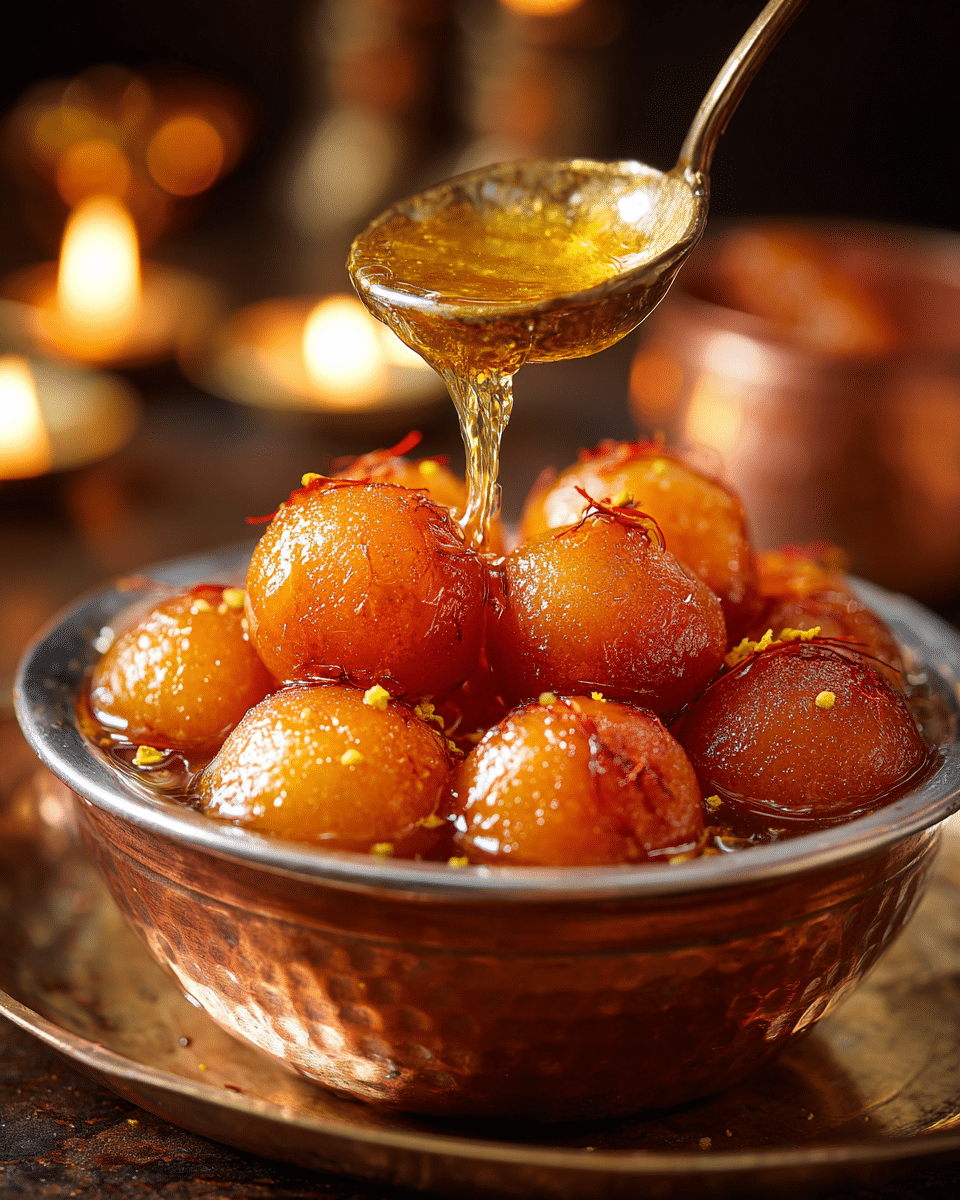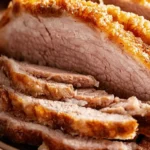Gulab Jamun is a beloved South Asian dessert, traditionally served during festive occasions, weddings, and celebrations. These soft, melt-in-your-mouth milk-based dumplings are deep-fried until golden brown and soaked in a fragrant sugar syrup infused with cardamom and rose water. With their rich texture and syrupy sweetness, gulab jamuns are a decadent treat that brings a touch of indulgence to any occasion.
FULL RECIPE
Ingredients
1.For the dough:
- 1 cup milk powder
- ¼ cup all-purpose flour
- 2 tablespoons semolina (sooji/rava)
- ½ teaspoon baking soda
- 2 tablespoons ghee (clarified butter)
- ¼ cup milk (warm, adjust as needed to form soft dough)
- Ghee or oil (for deep frying)
2.For the sugar syrup:
- 1½ cups sugar
- 1½ cups water
- 4–5 green cardamom pods (slightly crushed)
- 1 teaspoon rose water (or kewra water)
- A few saffron strands (optional)
- 1 teaspoon lemon juice (prevents crystallization)
Directions
- Prepare Sugar Syrup: In a saucepan, combine sugar, water, cardamom, and saffron. Bring to a boil, then simmer on low for 8–10 minutes. Stir in lemon juice and rose water. Keep warm.
- Make the Dough: In a mixing bowl, combine milk powder, flour, semolina, and baking soda. Add ghee and mix until crumbly. Gradually add warm milk to form a soft, smooth dough. Let rest for 10–15 minutes.
- Shape the Jamuns: Divide the dough into small equal portions and roll them into smooth, crack-free balls. Avoid pressing too hard to keep them airy inside.
- Heat the Oil/Ghee: In a deep pan, heat oil or ghee on medium-low. Test by dropping a tiny piece of dough—if it rises slowly, the oil is ready.
- Fry the Jamuns: Fry a few balls at a time, stirring gently and continuously to ensure even browning. Fry until deep golden brown (6–8 minutes).
- Soak in Syrup: Remove fried balls and drain excess oil. Place directly into warm sugar syrup. Let soak for at least 2 hours for optimal absorption.
- Serve: Gulab jamuns can be served warm or chilled, garnished with chopped pistachios or almonds if desired.
Nutrition Facts
- Calories: 290
- Protein: 4g
- Fat: 11g
- Saturated Fat: 5g
- Carbohydrates: 45g
- Sugar: 32g
- Fiber: 0g
- Cholesterol: 20mg
- Sodium: 80mg
Cultural Significance of Gulab Jamun
Gulab Jamun holds a cherished place in South Asian culinary traditions, especially in Indian, Pakistani, Bangladeshi, and Nepali cuisines. It is often served during festivals like Diwali, Eid, Holi, and weddings as a symbol of celebration, prosperity, and hospitality. The name “gulab” means rose, and “jamun” refers to a type of berry native to the Indian subcontinent, alluding to the dish’s floral aroma and round, dark shape. Its presence in rituals and feasts reflects its deep-rooted connection to joy, tradition, and togetherness.
Why Gulab Jamun is So Irresistible
The appeal of Gulab Jamun lies in its perfect balance of textures and flavors. The exterior is delicately crisp from frying, while the interior remains soft and almost sponge-like. Soaking in aromatic sugar syrup adds an indulgent sweetness and moistness that melts in the mouth. The combination of cardamom, rose water, and saffron in the syrup enhances the sensory experience with floral and warm spice notes, making each bite luxurious and comforting. This complexity in flavor and texture makes it stand out among global desserts.
Health Considerations and Moderation
While Gulab Jamun is undeniably delicious, it’s also a high-calorie, high-sugar treat best enjoyed in moderation. Each serving is rich in carbohydrates and fats due to its milk-based dough and deep-fried preparation. However, the use of cardamom and saffron adds small doses of antioxidants and digestive benefits. For those managing dietary concerns like diabetes or high cholesterol, occasional indulgence with portion control is advisable. Alternatively, baked or air-fried versions with natural sweeteners can offer a lighter take.
Common Variations Across Regions
Many regions have developed their own variations of Gulab Jamun. In Bengal, a version called “Pantua” uses chhena (fresh paneer) instead of milk powder. In Maharashtra, “Kala Jamun” features a darker, almost blackened crust and may include a filling of dry fruits. Some recipes incorporate khoya (reduced milk solids), enhancing the richness and creaminess. Others are infused with flavors like kewra (pandan essence), rose essence, or even orange blossom water, each bringing a unique regional touch to the classic recipe.
Pairing Suggestions for a Complete Dessert Experience
Gulab Jamun is often served solo, but it also pairs beautifully with other sweets and drinks. It’s common to enjoy it with a scoop of vanilla ice cream, offering a hot-and-cold contrast that’s especially popular at weddings and restaurants. A cup of masala chai or a mild dessert wine like Moscato can also complement its sweetness. For plated desserts, Gulab Jamun can be served with a smear of rabri (sweet thickened milk) or garnished with slivered nuts and edible gold leaf for an elegant finish.
Tips for Perfect Texture Every Time
Achieving the ideal Gulab Jamun requires attention to texture at every step. The dough should be soft and pliable, not dry or sticky, to prevent cracks that cause breakage during frying. Rolling the balls without applying pressure ensures a uniform structure and prevents dense centers. The frying oil must be kept at a medium-low temperature; too hot and the exterior browns too quickly, leaving the inside undercooked. Lastly, the syrup should be warm, not boiling, to allow gradual absorption without making the balls soggy.
Serving Styles for Different Occasions
Gulab Jamun can be adapted in presentation to suit various settings. For formal gatherings, they can be served in individual dessert cups with syrup and a sprinkle of nuts. During festivals or buffet-style dinners, they are often offered in large bowls or clay pots, allowing guests to help themselves. Miniature versions are ideal for cocktail parties or as part of a dessert platter. For wedding receptions, serving them with rabri or ice cream creates an upscale, plated dessert that impresses both in taste and appearance.
Storage and Reheating Guidelines
Proper storage extends the shelf life and enjoyment of Gulab Jamun. Once soaked in syrup, they can be refrigerated in an airtight container for up to 5–6 days. To serve warm, gently heat them in a microwave-safe dish for 30 seconds or on the stovetop by warming the syrup without boiling. Avoid reheating at high temperatures as this can cause them to become rubbery. For longer storage, some people freeze the fried balls (without syrup) and later thaw and soak them freshly in syrup when needed.
Making It Vegan or Lactose-Free
Traditional Gulab Jamun relies heavily on dairy, but vegan and lactose-free versions are possible with a few substitutions. Plant-based milk powder (such as coconut or almond) can replace dairy milk powder, and vegan butter or neutral oil can substitute for ghee. For the syrup, ensure that all ingredients used are plant-based, including any flavorings. These versions may have slight textural differences but still deliver the signature sweetness and spongy texture that defines the dish.
Advertisement
Innovative Twists for Modern Palates
Contemporary chefs and home cooks are constantly reimagining Gulab Jamun for new flavor profiles. Some popular innovations include chocolate-stuffed Gulab Jamun, pistachio or saffron-filled centers, and even matcha or espresso-infused versions. There are also fusion desserts like Gulab Jamun cheesecake, trifle, or layered parfaits that blend traditional and Western styles. These modern takes cater to evolving tastes and dietary expectations while celebrating the dessert’s timeless base.
Conclusion
Gulab Jamun is more than just a dessert—it’s a celebration in itself, steeped in tradition and beloved for its luxurious taste and texture. Whether you’re preparing it for a festive event, an intimate gathering, or just to satisfy a sweet craving, this dessert brings warmth, nostalgia, and indulgence to any table. With endless ways to customize and serve it, Gulab Jamun remains a versatile and treasured treat that continues to bridge cultures and generations with every syrup-soaked bite.






